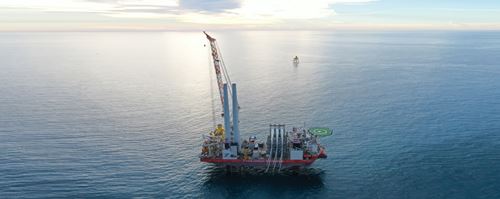Over the last few years, Fred. Olsen Windcarrier has been supporting offshore windfarm developers across APAC to help build the region’s renewable energy infrastructure.
Staying safe
Over the last few years, Fred. Olsen Windcarrier has been supporting offshore windfarm developers across APAC to help build the region’s renewable energy infrastructure.
In this part of the world, however, seismic activity is a constant threat that can present a serious danger for the vessel, crew, and turbine components on board. This is where experts such as Axel Wullf Wathne, Head of Engineering at Fred. Olsen Windcarrier, bring the expertise and experience needed to mitigate the risks as much as possible to keep people and assets safe – as was recently demonstrated at an offshore site in Taiwan.
Understanding the dangers
A major issue with seismic activity at sea is soil liquefaction. This is where cyclic motions can cause the seabed to become unstable, which can cause one or more of the legs of a jack-up vessel to suddenly penetrate deeper into the ground. It’s not hard to imagine what the results could be, especially if the crane was lifting 1000 tons of equipment!
Seismic activity isn’t something we need to worry about in European waters,” Axel says. “But in areas such as Taiwan, where we have been involved in several windfarm projects, it’s something we need to manage very carefully. Fortunately, we have a lot of expertise inhouse to do this and bring in third-party geotechnical expertise as and when needed.
Unshakable risk management
A challenge with seismic activity is that, unlike adverse weather conditions such as typhoons, you cannot forecast when and where it will happen. Everything therefore must start from studying local soil conditions and mapping out the potential risks, before working out how to keep these within acceptable levels.
It is a complex process. There are many variables, especially when you consider that earthquakes are never at the same magnitude, that nothing is 100% certain. Nevertheless, a rigorous Risk Assessment is always conducted and appropriate operational measures and safeguards put in place to minimize the window of exposure.
These mitigative measures could typically involve working to reduce vessel exposure time out of water, working at reduced airgap, and increasing operational efficiency to limit crane and lifting exposure times.
During a recent project in Taiwan, an earthquake did occur, says Axel.
This one measured 6 on the Richter scale at its epicenter, but this had reduced by the time the effects reached us. Nevertheless, crews onboard did experience unusual movements of the vessel!
Fortunately, this happened while one of our vessels was at the offshore site and the other was in transit, so there was no real danger.
Even though this particular earthquake was not a concern, Fred. Olsen Windcarrier’s meticulous risk mitigation process meant that soil conditions had to be reverified at the site of operation to ensure it was safe for works to continue.
Building a safer future
Even against these natural obstacles, Fred. Olsen Windcarrier is helping the offshore wind farm industry gather pace across the APAC region, with Taiwan leading the way.
“The risk of seismic activity will never go away,” says Axel, “but with the vast pool of expertise we can draw upon, and careful risk assessment and planning, we will continue to ensure windfarm installation projects in APAC remain as safe and efficient as possible.”
